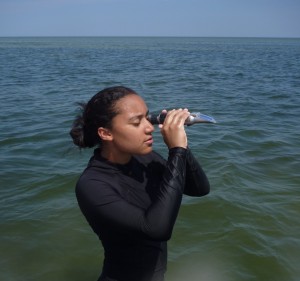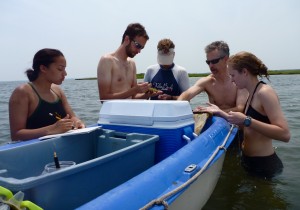This is science?
By Kara Gadeken, College of William & Mary undergraduate student

Undergraduate student Kara Gadeken takes water salinity measurements at Goodwin Islands, Virginia USA
Interning at VIMS during the hectic months when the ZEN project was at its peak was an experience that I will never forget.
The main reason that I wanted to take part in it was that, as an impassioned yet inexperienced college student, I had a reasonable knowledge base in biology but had no idea what it was like to actually do research, much less to be a part of such a grand-scale project as the ZEN. I approached Dr. Duffy at the suggestion of one of my professors at William and Mary, and luckily enough at this point his lab could use all of the help I could give.
I think the first thing that I realized while working in the Marine Biodiversity lab was that an insane amount of planning and preparation goes into research. Pamela had sticky notes and checklists and reminders all over everything in the lab, and two weeks of putting supplies together could count on one efficient day in the field. I also discovered that biologists, and especially experimental ecologists, almost have to have some engineering blood in them. In my first week at VIMS I sat in on a lab meeting to figure out how to design and construct cages to exclude predatory fish and crabs out in the seagrass beds. Time after time I heard, “How about this random thing? Hmm, I’m not sure that’ll work…How about this other random thing? Yeah, we can make something out of that!” Someone would hold up a piece of bent wire, some cable ties, bits of rope and mesh, some plastic plates. They hurled out idea after idea, trying to come up with something that could be constructed into a cage-like apparatus that would anchor into the sediment and withstand the waves. I remember stitching mesh together on an industrial sewing machine thinking, “This is science?” It didn’t take me long to realize that experiments are complicated. Not everything is perfect, and sometimes you have to work with what you’ve got, or make something new. And that’s okay – it can even be pretty fun. It’s a challenge of experimentation that, until now, I didn’t know existed.
I would definitely have to say that the days we spent in the field were my favorite days of work. Every time we would go out to the site I would see something new – a ray, a nesting osprey, a terrapin, leaping houdfish. By far, my favorite part of the experiment was the predator surveys with the giant seine net. It was like playing the lottery, but for biology nerds. Each time we pulled the net up I would get so excited to see what was in it – a huge blue crab, a cute little pipefish, or a new (to me) species of fish.
I learned a lot while helping out with the ZEN, most importantly:
1. Oreos and zucchini bread make the absolute best field day treat.
2. Terrapin turtles are the mean old men of the sea.
3. Atlantic rays do not like being stepped on. Do the shuffle!
4. A double hitch is a thoroughly unacceptable method of tying off a boat.
5. Cable ties can fix absolutely anything.
And I did learn some about marine biology too. The emphasis on biodiversity and experimentation was paramount, but I think the more important thing that I took away was that the people who work at VIMS are completely awesome. They are passionate about their work, and really do genuinely enjoy it. It’s the sort of work environment that I would want to have in my career in biology.
Even though my turn with the ZEN is over, if they’ll have me I’d love to come back sometime!
Photos by JE Duffy



Comments are closed.